
Moa are an extinct group of flightless birds formerly endemic to New Zealand. During the Late Pleistocene-Holocene, there were nine species. The two largest species, Dinornis robustus and Dinornis novaezelandiae, reached about 3.6 metres (12 ft) in height with neck outstretched, and weighed about 230 kilograms (510 lb) while the smallest, the bush moa, was around the size of a turkey. Estimates of the moa population when Polynesians settled New Zealand circa 1300 vary between 58,000 and approximately 2.5 million.

Dracophyllum is a genus of plants belonging to the family Ericaceae, formerly Epacridaceae. There are 61 species in the genus, mostly shrubs, but also cushion plants and trees, found in New Zealand, Australia, Lord Howe Island and New Caledonia. The name Dracophyllum, meaning dragon-leaf, refers to their strong outward similarity to the unrelated Dracaena, sometimes known as dragon tree. Although dicotyledonous, they resemble primitive monocots with their slender leaves concentrated in clumps at the ends of the branches; they are sometimes called grass-trees.

Libertia is a genus of monocotyledonous plants in the family Iridaceae, first described as a genus in 1824. It is native to South America, Australia, New Guinea, and New Zealand. Eight species are endemic to New Zealand.

Oreostylidium is a genus of flowering plants in the family Stylidiaceae with a single species, Oreostylidium subulatum, that is endemic to New Zealand. O. subulatum is a very small plant with small, white flowers. It has a complicated botanical history that has led to a few proposals to move Oreostylidium to the related genus Stylidium. The researchers cite molecular data and suspect that this species is an extreme example of floral paedomorphosis. This would not be an unprecedented move since the single species was initially described as Stylidium subulatum in 1864 and later moved to its own genus by Sven Berggren in 1878. It possesses the same kind of glandular trichomes underneath the flower that make Stylidium species carnivorous plants, but it has not yet been tested for the presence of digestive enzymes.

Libertia grandiflora, the tukauki or mikoikoi, is a flowering plant in the family Iridaceae. The species is endemic to New Zealand, and is found on the North Island and the northern part of the South Island. It is a clump-forming herbaceous perennial growing to 90 cm (35 in) tall by 60 cm (24 in) broad, with leathery linear leaves and panicles of white flowers in spring, followed by seed capsules. The Latin grandiflora means large flowered; its flowerheads can grow up to three centimetres across.

Myosotis pansa subsp. pansa, also known as the Waitakere forget-me-not, is a subspecies of flowering plant in the family Boraginaceae, endemic to the North Island of New Zealand. Lucy Moore described the variety M. petiolata var. pansa in 1961, and it was transferred to a subspecies of M. pansa by Heidi Meudt, Jessica Prebble, Rebecca Stanley and Michael Thorsen in 2013. Plants of this species of forget-me-not are perennial rosettes with ebracteate inflorescences and white corollas with exserted stamens.

Pachystegia is a genus of shrubs in the family Asteraceae, known as Marlborough rock daisies, with distinctive leathery leaves and daisy-like flowers. They are naturally found only in dry areas of the north-eastern South Island of New Zealand.

Libertia ixioides is a flowering plant in the family Iridaceae. The species is endemic to New Zealand. It is a rhizome-forming herbaceous perennial. The Latin ixioides means like an ixia, due to its similarities with that plant species.
Petalophyllum, or petalwort, is a genus of liverworts in the order Fossombroniales.
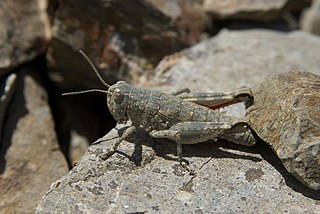
Brachaspis nivalis, is an alpine short-horned grasshopper, endemic to the South Island of New Zealand. Brachaspis nivalis is brachypterous and flightless, therefore they travel by hopping. They bask during the day so need open habitat.

Libertia chilensis, synonym Libertia formosa, called the New Zealand satin flower, snowy mermaid, or Chilean-iris, is a species of flowering plant in the iris family, Iridaceae, native to the Juan Fernández Islands, central and southern Chile, and southern Argentina. It can also be found growing wild in the San Francisco Bay Area and San Bernardino County in California, where it is an introduced species. A rhizomatous evergreen perennial, it has gained the Royal Horticultural Society's Award of Garden Merit.
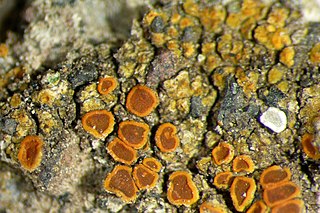
Caloplaca allanii is a species of saxicolous (rock-dwelling) and crustose lichen in the family Teloschistaceae. Found in New Zealand, it was formally described as a new species by Alexander Zahlbruckner. The type specimen was collected by Lucy Cranwell on Anawhata Beach in 1932; she sent a dried specimen to Zahlbruckner for identification. The specific epithet allanii honours New Zealand botanist Harry Allan.
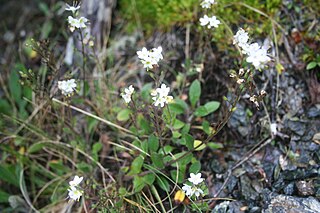
Myosotis brockiei is a species of flowering plant in the family Boraginaceae, endemic to southern South Island of New Zealand. Lucy Moore and Margaret Simpson described the species in 1973. Plants of this species of forget-me-not are perennial rosettes which form loose tufts or clumps, with ebracteate, erect inflorescences, and white corollas with exserted stamens.

Myosotis pansa is a species of flowering plant in the family Boraginaceae, endemic to the North Island of New Zealand. Lucy Moore described the variety M. petiolata var. pansa in 1961, and it was raised to species level as M. pansa by Heidi Meudt, Jessica Prebble, Rebecca Stanley and Michael Thorsen in 2013. Plants of this species of forget-me-not are perennial rosettes with ebracteate inflorescences and white corollas and exserted anthers.
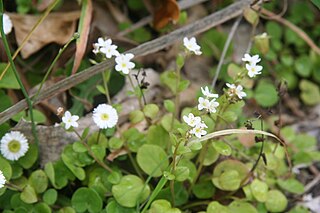
Myosotis pansa subsp. praeceps is a subspecies of flowering plant in the family Boraginaceae, endemic to the North Island of New Zealand. Lucy Moore described the variety M. petiolata var. pansa in 1961, and it was transferred to a subspecies of M. pansa by Heidi Meudt, Jessica Prebble, Rebecca Stanley and Michael Thorsen in 2013. Plants of this species of forget-me-not are perennial rosettes with partially bracteate inflorescences and white corollas with exserted stamens.
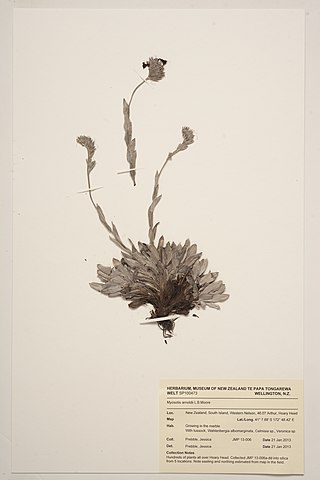
Myosotis arnoldii is a species of flowering plant in the family Boraginaceae, endemic to the South Island of New Zealand. Lucy Moore described the species in 1961. Plants of this species of forget-me-not are perennial rosettes with ebracteate inflorescences, corollas ranging from yellow to dark purple, and stamens that are wholly exserted.

Pteris macilenta is a species of fern endemic to New Zealand.
John E. Braggins is a New Zealand botanist and bryologist, known for his research into ferns and liverworts. Braggins lectured at the University of Auckland from 1969 until 2000, during which time he supervised and mentored a significant number of New Zealand botanists. During Braggins' career, he has taken part in the identification of 12 species and one suborder, many of which are endemic New Zealand liverworts.

Libertia cranwelliae is a species of flowering plant in the family Iridaceae. The plant was first described by Dan Blanchon, Brian Grant Murray and John E. Braggins in 2002, and is native to New Zealand.
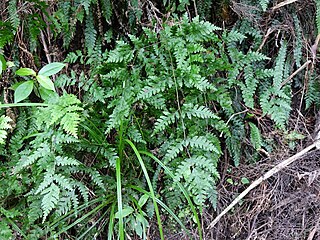
Pteris carsei is a species of fern native to New Zealand, including the Kermadec Islands. Originally considered a subtype of Pteris comans, the species was first formally described by Patrick Brownsey and John E. Braggins in 2020.


















